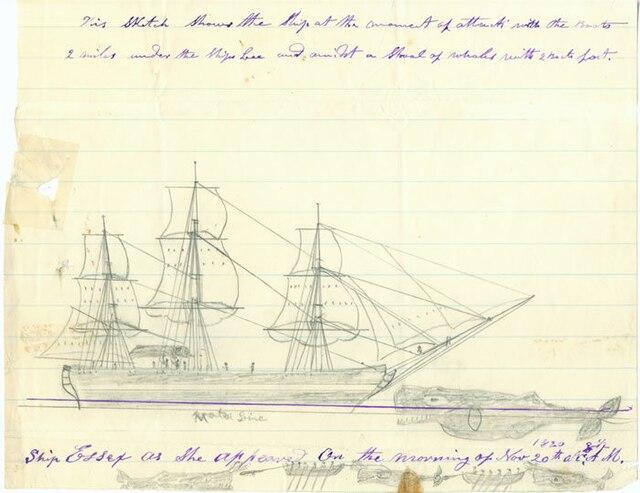We have seen how Herman Melville waxed lyrical about the prodigious skills of the Nantucket men who navigated the world’s oceans in search of the oil of the sperm whale, likening them to Alexander the Great. We have also seen that he wrote of their exploits in the novel Moby Dick, the story of Captain Ahab’s search to take revenge on the great white whale which had destroyed his ship on an earlier voyage.
To many this notion that a whale would deliberately destroy a whaling vessel is fantastical, but not so. Such an event did occur to a Nantucket ship. Her name was the Essex, which set forth from Nantucket bound for the South Pacific Ocean in August 1819. Under the command of Captain George Pollard, she had a total of 20 crew members, named here in a letter dated 13 February 1821.
Like all such journeys it was of many months duration and not especially noteworthy. This is, until 20th November 1820, when the Essex was thousands of miles off the coast of South America.
On that momentous day the crew had spotted a pod of whales and dispatched their 3 small whaleboats in pursuit. The mate’s boat was damaged by a whale and as he was repairing it, the crew noticed a whale acting most strangely. By all accounts the animal was very large – some 85 feet or 26 m in length. It appeared to lie quietly and then swam towards the ship, rapidly picking up speed and rammed it, before coming up underneath and almost flipping the ship over. Swimming away, it turned for one final attack and in the words of the mate, Owen Chase, “I turned around and saw him about one hundred rods [500 m or 550 yards] directly ahead of us, coming down with twice his ordinary speed of around 24 knots (44 km/h), and it appeared with tenfold fury and vengeance in his aspect. The surf flew in all directions about him with the continual violent thrashing of his tail. His head about half out of the water, and in that way he came upon us, and again struck the ship.”
The ship sank and the crew took to their whaleboats with what few supplies they could find. Their subsequent story is one of desperation and despair, as they attempted to sail back to South America. As men died of thirst and starvation, some were buried at sea, but in the end, the survivors resorted to cannibalism in a bid to remain alive.
Owen Chase, Benjamin Lawrence and the cabin boy, Thomas Nickerson, survived this ordeal. Their boat was separated from the other 2 whaleboats, and they were eventually picked up by the British whaleship Indian, after 90 days at sea.
The second whaleboat, under the command of Obed Hendricks was separated from that of Captain Pollard and its crew were never seen again.
Pollard’s whaleboat was rescued by the Nantucket whaleship Dauphin, on February 23, 95 days after their ordeal commenced.
The story has now been brought to life on the big screen in a movie called ‘In the Heart of the Sea’, directed by Ron Howard. Scheduled for release in March 2015, here is a preview.

Leave a Reply